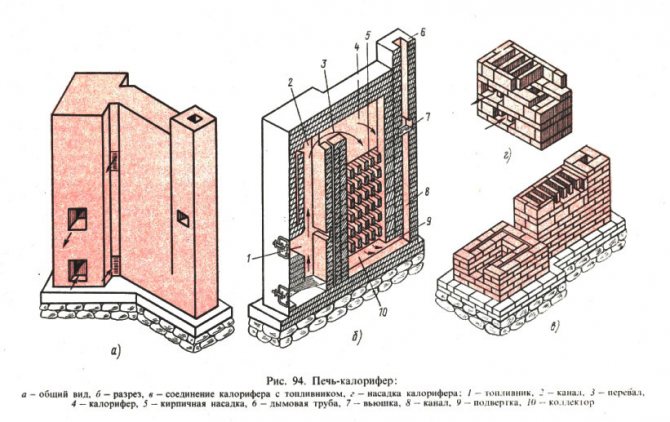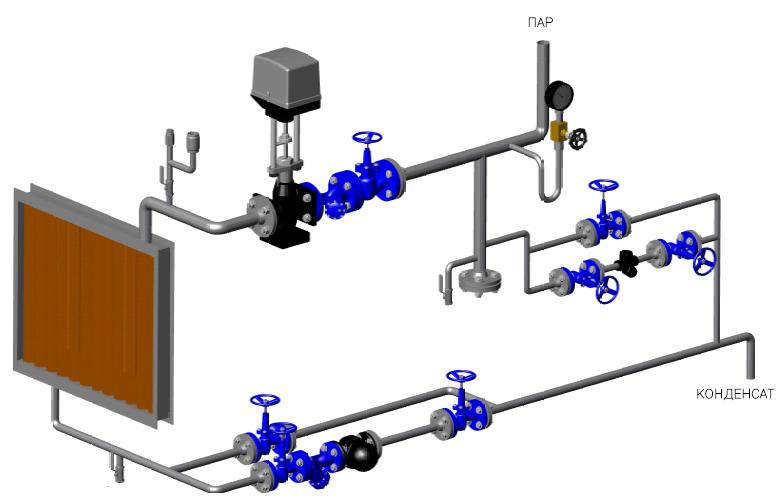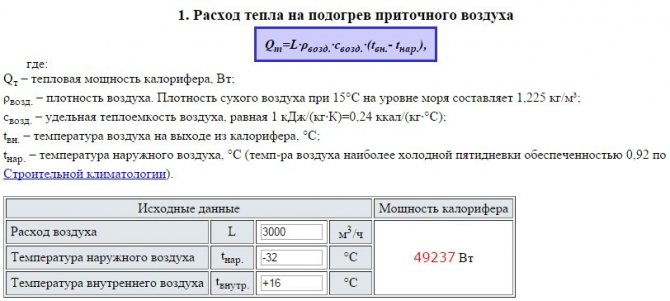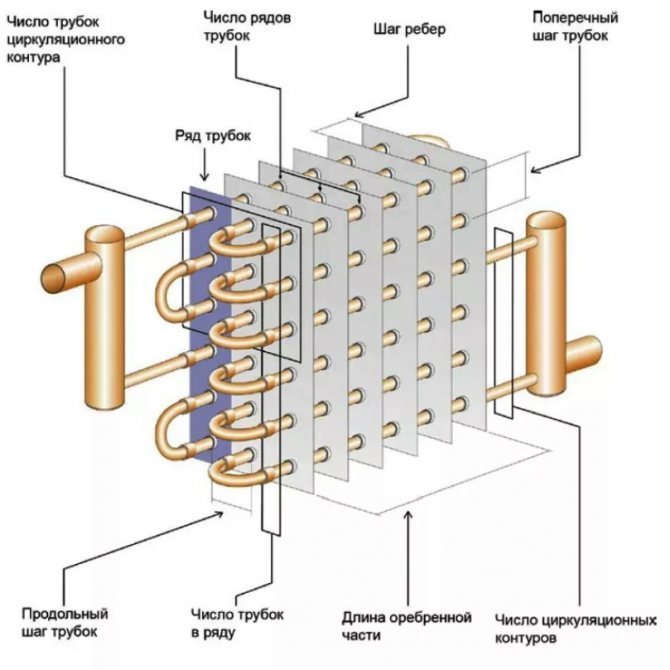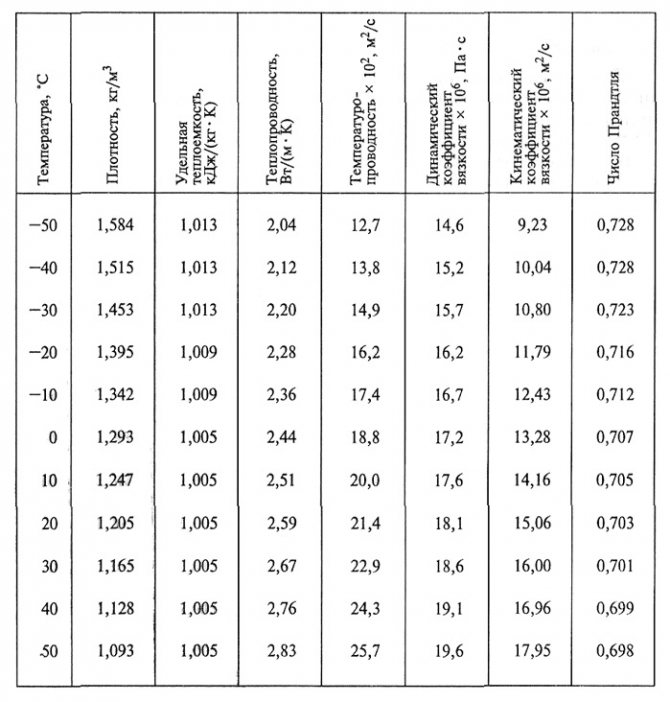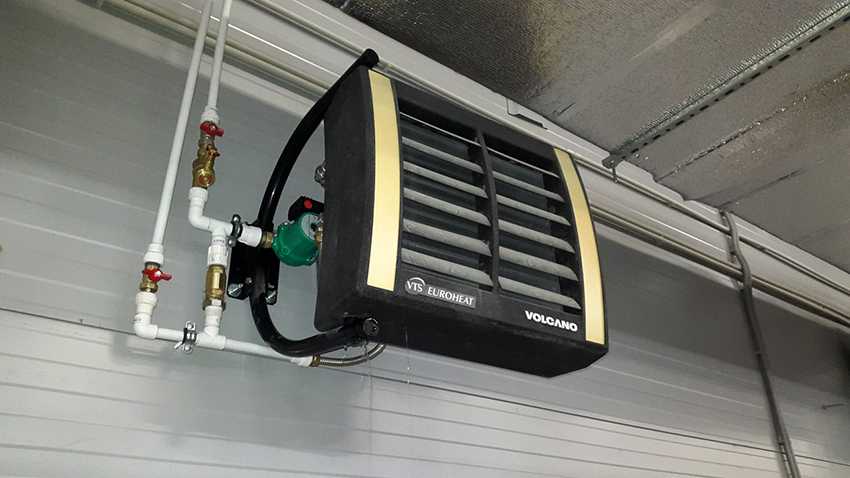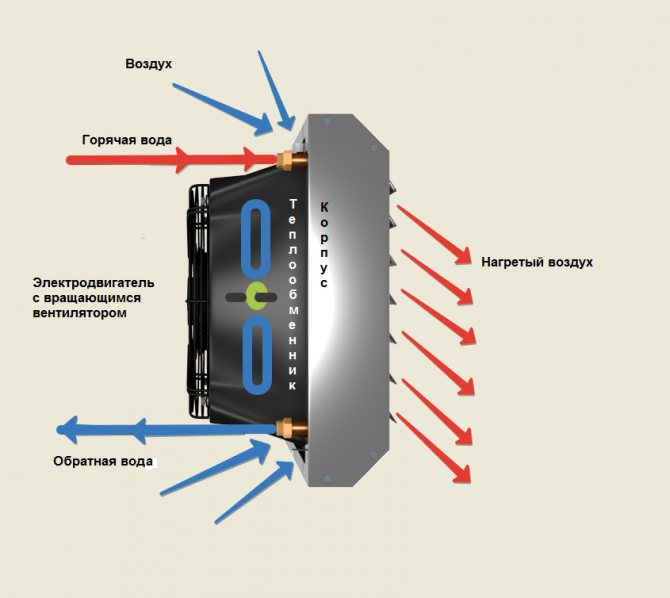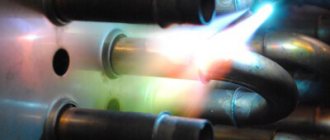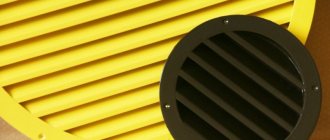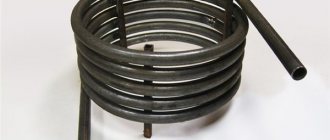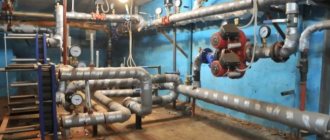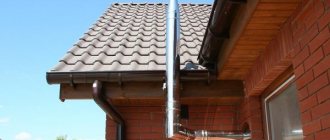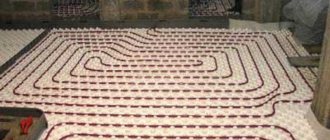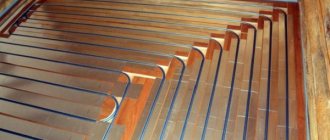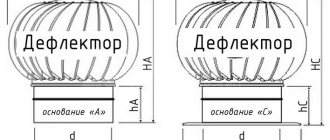Calculation of performance for heating air of a certain volume

Determine the mass flow rate of heated air
G
(kg / h) =
L
x
R
Where:
L
- volumetric amount of heated air, m3 / hour
p
- air density at average temperature (the sum of the air temperature at the inlet and outlet from the heater is divided by two) - the table of density indicators is presented above, kg / m3
Determine the heat consumption for heating air
Q
(W) =
G
x
c
x (
t
con -
t
beginning)
Where:
G
- mass air flow rate, kg / h s - specific heat capacity of air, J / (kg • K), (the indicator is taken from the temperature of the incoming air from the table)
t
start - air temperature at the inlet to the heat exchanger, ° С
t
con is the temperature of the heated air at the outlet of the heat exchanger, ° С
Exhaust ventilation calculation example
Before the beginning exhaust ventilation calculation it is necessary to study the SN and P (System of Norms and Rules) of the device of ventilation systems. According to SN and P, the amount of air required for one person depends on his activity.
Low activity - 20 cubic meters / hour. Average - 40 m3 / h. High - 60 m3 / h. Next, we take into account the number of people and the volume of the room.
In addition, you need to know the multiplicity - a complete exchange of air within an hour. For the bedroom, it is equal to one, for household rooms - 2, for kitchens, bathrooms and utility rooms - 3.
For example - calculation of exhaust ventilation rooms 20 sq.m.
Let's say two people live in the house, then:
V (volume) of the room is equal to: SxH, where H is the height of the room (standard 2.5 meters).
V = S x H = 20 x 2.5 = 50 cubic meters.
Further V x 2 (multiplicity) = 100 cubic meters / h. In another way - 40 km / h. (average activity) x 2 (person) = 80 cubic meters / hour. We choose a larger value - 100 mb / h.
In the same manner, we calculate the performance of the exhaust ventilation of the whole house.
Calculation of the frontal section of the device required for the passage of the air flow
Having decided on the required thermal power for heating the required volume, we find the frontal section for the air passage.
Frontal section - working internal section with heat-transfer tubes, through which flows of forced cold air pass directly.
f
(sq.m.) =
G
/
v
Where:
G
- mass air consumption, kg / h
v
- air mass velocity - for finned air heaters it is taken in the range of 3 - 5 (kg / m.kv • s). Allowable values - up to 7 - 8 kg / m.kv • s
Advantages and disadvantages of water heaters
A water heater for supply ventilation has significant disadvantages that limit its use in residential premises:
- large dimensions;
- the complexity of connecting to a common hot water supply system;
- the need for strict control of the temperature of the coolant in the water supply system.
However, in order to create a comfortable temperature in large rooms (production halls, greenhouses, shopping centers), the use of such heating units is the most convenient, efficient and economical.
The water heater does not load the power grid, its breakdown will not provoke a fire - these factors make the use of the equipment safe.
Calculating Mass Velocity Values
Find the actual mass velocity for the air heater
V
(kg / m.kv • s) =
G
/
f
Where:
G
- mass air consumption, kg / h
f
- the area of the actual frontal section taken into account, sq.
Expert opinion
Important!
Can't handle the calculations yourself? Send us the existing parameters of your room and the requirements for the heater. We will help you with the calculation. Alternatively, look at existing questions from users on this topic.
Types of air heaters
As mentioned earlier, air heaters are divided according to the principle of operation and each type has its own advantages and disadvantages:


Electric heater connection diagram.
- Electric heaters are easy to install and simple enough to operate when used in a ventilation system to heat the passing air. However, most electric heaters are of limited capacity, so the use of an electric heater is acceptable in those types of ventilation that are not designed for an air flow of more than 4500 m3 / h. In addition, electric heaters have another significant drawback - high operating costs, especially when using an electric heater during winter cold weather. Depending on the power of the electric heater, changes in the electrical wiring may be required: if heaters with a power of up to 5 kW can be connected to both single-phase (220 V) and three-phase (380 V) networks, then connecting an electric heater with a power of more than 5 kW is possible only to a three-phase electrical network;
- Water heaters use hot water to heat the air passing through them, therefore they must be connected to an autonomous (gas or electric boiler in a private house) or central (for office buildings or enterprises) heating system. Water heaters are much more powerful than their electrical counterparts and can be used in ventilation systems with a throughput of 1,000 to 16,000 cubic meters of air per hour. The disadvantages of this type of heaters include the fact that they are more difficult to install and operate. In addition, hot water heaters are subject to the risk of defrosting and therefore cannot be left without a constant warm water supply during winter.
- Steam heaters are the most common types of air heaters. Their popularity directly depends on their useful qualities and technical characteristics. A steam air heater quickly warms up the air in the room, and if we compare it with other types of air heaters, then it is the leader in this indicator. However, steam air heaters suffer from the disadvantages of similar water systems. They must always be supplied with hot steam, as their work depends on it. In addition, steam heaters do not have a constant heating power value, they depend on the temperature and pressure of the water vapor. However, such disadvantages are more than overlap with the advantages of this type of heaters: since they operate from steam generators, they are quite economical for various kinds of enterprises; their operation does not require large energy costs, steam heaters are quite reliable and durable.
Calculation of the thermal performance of a heating installation
Calculation of the actual heat output:
q
(W) =
K
x
F
x ((
t
in +
t
out) / 2 - (
t
start +
t
con) / 2))
or, if the temperature head is calculated, then:
q
(W) =
K
x
F
x
average temperature head
Where:
K
- heat transfer coefficient, W / (m.kv • ° C)
F
- heating surface area of the selected heater (taken according to the selection table), sq.
t
in - water temperature at the inlet to the heat exchanger, ° С
t
out - water temperature at the outlet of the heat exchanger, ° С
t
start - air temperature at the inlet to the heat exchanger, ° С
t
con is the temperature of the heated air at the outlet of the heat exchanger, ° С
Air heater classification
Heaters are included in the design of the heating system to heat the air.There are the following groups of these devices according to the type of coolant used: water, electric, steam, fire.
It makes sense to use electrical appliances for rooms with an area of no more than 100 m². For buildings with large areas, a more rational choice would be water heaters, which function only with a heat source.
The most popular are steam and water heaters. Both the first and the second in shape surfaces are divided into 2 subspecies: ribbed and smooth-tube. Finned heaters in the geometry of the ribs are plate and spiral wound.
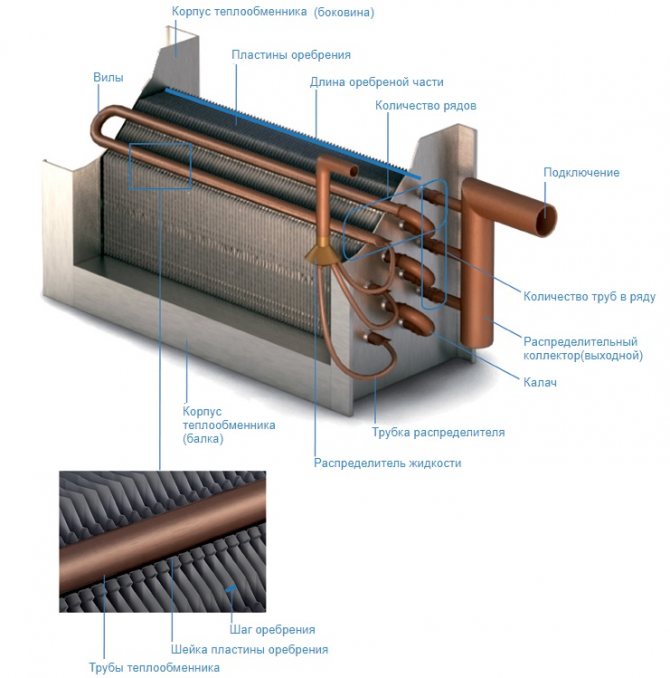

The performance of heaters operating on a heat carrier such as steam is controlled by means of special valves installed on the inlet pipe.
By design, these devices can be single-pass, when the coolant in them moves through the tubes, adhering to a constant direction, and multi-pass, in the covers of which there are partitions, as a result of which the direction of movement of the coolant is constantly changing.
4 models of water and steam heaters are on sale, differing in the heating surface area:
- CM - the smallest with one row of pipes;
- M - small with two rows of pipes;
- FROM - medium with pipes in 3 rows;
- B - large, with 4 rows of pipes.
Water heaters during operation withstand large temperature fluctuations - 70-110⁰. For good operation of this type of heater, the water circulating in the system must be heated to a maximum of 180⁰. In the warm season, the air heater can act as a fan.
Image gallery
Photo from
Water heater in the production area
Steam heater on a glazed terrace
Compact electric air heater
Steam spiral wound model
Calculation of the mixing air curtain
Structural elements of air curtains
Vane-type curtains, as a rule, are designed with two-way air discharge and are composed of two independent units, consisting of radial or axial fans, air heaters if the curtain is air-thermal, and air distribution boxes, which are installed on each side of the opening to be opened.
The air distribution boxes of the curtain are located on the inside of the opening at a distance of no more than 0.1 (where Fпр is the area of the open opening equipped with the curtain). In the absence of space for the installation of boxes directly at the openings, curtains with extended air outlet nozzles are used. The air stream of the curtain should be directed at an angle of 300 to the plane of the opening. The height of the air outlet is taken equal to the height of the open opening. The design of the air distribution boxes must ensure the horizontal movement of the air curtain's air stream and the ratio of the minimum air outlet velocity to the maximum slot height at least 0.7. As a rule, air is taken into the vane-type curtain at the level of the suction pipe of the fan. When installing the fan on the floor, it is recommended to take air from the upper zone of the room if the air temperature in the upper zone is 50C or more higher than the temperature in the working zone.
The air outlet from the mixing type air-thermal curtains should be provided on both sides in the immediate vicinity of the doors being opened, so that the curtain air flows are not interrupted by the opening doors. The design of the air outlets must ensure the horizontal direction of the curtain air flow. The height of the air outlets is taken from 0.1 to 1.6 m from the floor, the width is determined by calculation. The air intake for the curtain, as a rule, is carried out under the ceiling of the lobby. Air intake from outside is provided when combining an air-thermal curtain with supply ventilation.It is recommended to supply air: with air intake from the room - into the vestibule, with air intake from outside - into the lobby.
For rooms with explosive industries, fans in an intrinsically safe design must be used, and the temperature of the coolant for the air heaters through which the recirculated air passes must not exceed 80% of the autoignition temperature of gases, vapors or dust. If hot water is used as a heat carrier, its temperature for production categories A, B, and E in the presence of combustible and explosive dust in the premises should not be higher than 1100 C, and in its absence, not higher than 1500 C. In the absence of appropriate spark-proof equipment for the curtain in rooms with categories A, B and E, it is allowed to take outside air or air from adjacent rooms of categories C, D and D if there is no combustible dust in it.
Automation means for air curtains must ensure: starting the fan when the serviced opening is opened and when the temperature near the closed opening is lower than the set value; turning off the fan after closing the serviced opening and when the air temperature near the closed opening is restored to the set value.
30.2. Calculation of a gate type curtain
The total flow rate of air supplied by the gate-type curtain is determined by the formula
, (30.1)
where is the characteristic of the curtain - the ratio of the flow rate of the air supplied by the curtain to the flow rate of air passing into the room through the opening during the operation of the curtain; - the coefficient of the flow rate of the opening during the operation of the curtain (taken depending on and; Fпр - the area of the opening equipped with the curtain, m2; - the difference in air pressures from both sides of the outer fence at the level of the opening, Pa; - density, kg / m3, of the mixture supplied by the curtain and the outside air at a temperature tcm equal to the standard.
The pressure difference is determined by calculation as a result of solving the equations of air balances, taking into account the wind pressure for the cold mode of the year.
For approximate calculations, if there is no complete initial data, the value can be taken by the formula
, (30.2)
where k1 is a correction factor for wind pressure, taking into account the degree of tightness of buildings;
; (30.3)
, (30.4)
where hcalc is the calculated height, i.e. the vertical distance from the center of the opening equipped with a curtain to the level of zero pressures, where the pressures from outside and inside the building are equal (height of the neutral zone), m; - air density, kg / m3, at the outside air temperature (parameters B); - the same, at the average height of the premises, the internal air temperature tв; - the estimated wind speed, the value of which is taken with the parameters B for the cold period of the year; с - calculated aerodynamic coefficient, the value of which should be taken according to SNiP 2.01.07-85.
The estimated height hcalculated can be taken approximately;
a) for buildings without aeration openings and lanterns
, (30.5)
where hpr is the height of the opening to be opened;
b) for buildings with aeration openings closed during the cold season,
, (30.6)
where h1 is the distance from the center of the opening equipped with a curtain to the center of the supply openings, m; h2 is the distance between the centers of the supply and exhaust openings, m; lp is the length of the porches of the supply openings, which are opened in the warm season, m; lv - the same, exhaust openings;
c) for buildings with aeration openings open during the cold season:
, (30.7)
or
,
where hp is the distance from the center of open supply aeration openings to the level of zero pressure obtained when calculating aeration in the cold season (parameters B), m; - the products of the flow rates of the openings, respectively, of the supply and exhaust aeration openings and their areas, m2.
In the presence of an imbalance and excess in the room of the mechanical exhaust over the inlet value, approximately, it can be determined by the following formulas:
a) when air intake for the curtain from the room
; (30.8)
b) when air intake for the curtain from the outside
, (30.9)
where is the sum of the products of the flow rates of open supply openings and their areas, m2; - the sum of the products of the flow coefficients of simultaneously opened openings, equipped with curtains, and their areas, m2.
When calculating, you should check the value of Gz according to the formula (30.1), and for the estimated flow rate take the larger of the values obtained by the formula
(30.8) and (30.1) or (30.9) and (30.1). The value should not exceed a single exchange of 1 hour.
The required air temperature of the curtain tg is determined on the basis of the heat balance equation according to the formula
, (30.10)
where is the ratio of the heat lost with the air leaving through the openings to the outside to the heat output of the curtain.
Thermal power of air-heating curtain heaters
, (30.11)
where A = 0.28 is the coefficient: tinit is the temperature of the air taken in for the curtain, 0С.
If, as a result of calculating tz, it turns out to be less than tinit, then curtains without heating sections should be used.
30.3. Combined air curtain calculation
To save thermal energy, it is advisable to use combined air-heat curtains (KVTZ), which supply part of the air without heating. KVTZ consists of two pairs of vertical air distribution boxes installed inside the premises. The outer pair of risers, located closer to the gate, does not drop heated air, but the inner steam, heated to 70 ° C, which reduces the heat loss of the air curtain jet.
The calculation of KHTZ is carried out in the following order. The relative air flow rate and the relative area of the slots in the outer pair of the air curtain risers are set. It is recommended to take. The values are used to determine the relative heat losses with the jet of the outer curtain. When,. Then the relative air flow through the "internal" curtain is calculated using the formula
(30.12)
The relative area of the air outlet slots of the "inner curtain" is calculated
(30.13)
The total relative area of the air outlet slots and the total relative flow rate of the KVTZ are determined
(30.14)
(30.15)
Based on the obtained values and, the total air flow supplied by the KHTZ is found and calculated according to the formula (30.1). After that, the air flow through the external and internal curtains is determined, respectively.
(30.16)
(30.17)
The thermal power of KVTZ heaters is calculated by the formula (30.11) at and
30.4. Mixing type curtain calculation
The air consumption for a mixing type air curtain is determined by the formula
, (30.18)
where k is a correction factor for taking into account the number of people passing by, the place of air intake for the curtain and the type of lobby; - flow coefficient, depending on the design of the entrance; Fвх - area of one openable sash of external entrance doors, m2. When combining the air-thermal curtain with supply ventilation, the value of Gz is taken equal to the air flow required for supply ventilation, but not less than the value determined by the formula (30.18).
The value is determined as a result of calculating the air regime of the building, taking into account the wind pressure. In the absence of complete initial data, it can be calculated using the formula (30.3), where the value of hcalculated is calculated taking into account the wind pressure depending on the number of storeys of the building according to the formulas:
for buildings with 3 or less floors
(30.19)
for buildings with more than 3 floors
(30.20)
where hl.k. - the height of the staircase from the planning level of the ground, m; hдв - height of the door leaf, m; he is the total height of one floor, m.
The thermal power of the air heaters of the air-thermal curtain is determined by the formula (30.11).
